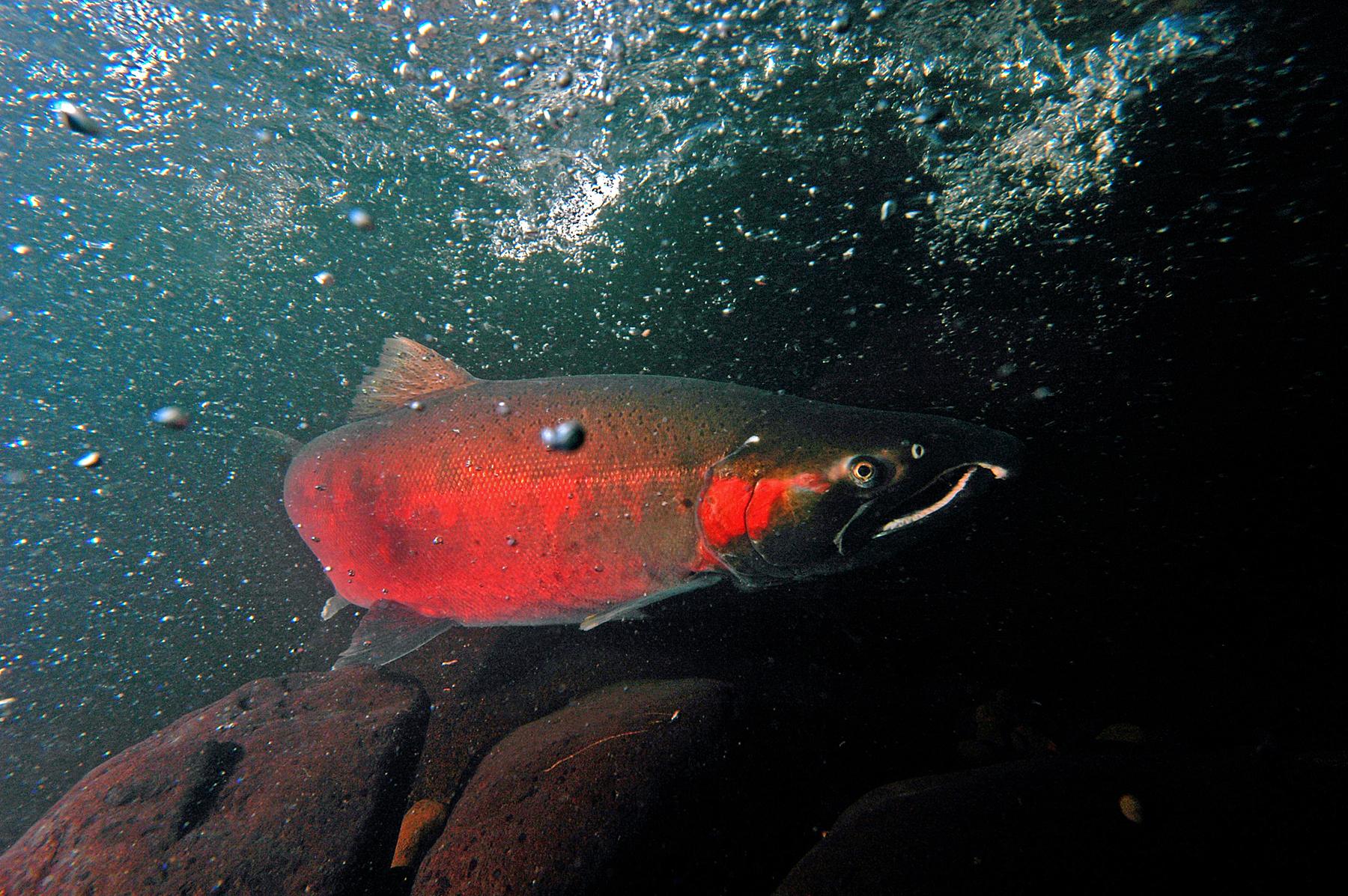
A coho salmon makes its way up Cedar Creek on its way to the Sandy fish hatchery.
Rick Swart / Oregon Department of Fish and Wildlife
Decades of data show that despite billions in taxpayer investment, salmon and steelhead hatchery programs and restoration projects in the Columbia River Basin have failed to support or boost native fish populations and in fact are contributing to their decline.
Oregon State University economics professor William Jaeger and Mark Scheuerell, a biologist with the U.S. Geological Survey and the University of Washington, looked at 50 years of native and hatchery salmon and steelhead return data from the Bonneville Dam near Cascade Locks. The Bonneville Dam is the last of 14 dams on the Columbia River before it empties into the Pacific Ocean, and it is where many salmon and steelhead — both those born in hatcheries and in the wild — return to deposit their eggs after one to seven years in the ocean. The two also reviewed decades of spending on habitat restoration and hatcheries programs in the river basin, meant to save the species from extinction.
Jaeger and Scheuerell found that while the number of salmon and steelhead born in hatcheries that return as adults has grown slightly, wild populations of salmon and steelhead have not, and in some cases they’re being hurt by the hatchery fish. The growth in hatchery fish populations has in some cases resulted in the spread of disease and increasing competition for food with native fish, Jaeger noted. Scientists have even found that some hatchery fish prey on wild fish.
The study was published July 28 in the journal PLOS One.

A file, aerial view of the Bonneville Dam. Bonneville Power Administration is the largest electricity provider in the Northwest.
Amelia Templeton
“The actual impact of all of these efforts has always been poorly understood,” Jaeger said in a news release.
There are about 200 salmon hatchery programs in the Columbia River Basin, and 80% of all salmon and steelhead that return to the Columbia River as adults started their lives in hatcheries, according to the National Oceanic and Atmospheric Administration fisheries division.
The cost to taxpayers to maintain these hatcheries during the last 40 years has been about $9 billion when adjusted for inflation, according to Jaeger. This does not include any of the money spent by local governments or nonprofits and nongovernment agencies.
“We found no evidence in the data that the restoration spending is associated with a net increase in wild fish abundance,” Jaeger said.
David Moskowitz, executive director of the nonprofit Conservation Angler which works to protect wild salmon and steelhead, said $9 billion dollars in the last four decades is probably a low figure.
“That doesn’t even take into account the costs of all the management that goes on,” he said.
‘Failed promise’
Steelhead, Chinook, coho and sockeye numbers have been declining in the Columbia River Basin for more than 150 years, according to the U.S. Fish and Wildlife Service. Overfishing and damming of the river for hydropower have played the largest role. Other factors hurting the fish include farming pollution and the loss of water to irrigation, climate change, as well as habitat loss due to logging and mining.
The growth of hatcheries during the last century was a response to the growth of dams. State and federal governments made a promise to Columbia Basin tribes and to the public that any salmon or steelhead lost to dams would be replaced.
“The hatchery promise was made without any idea if it would work. It was a failed promise,” Moskowitz said.
Prior to damming, an estimated 16 million salmon and steelhead returned to the Columbia River in the area above what is now Bonneville Dam each year. But by the 1970s, less than 1 million were returning.
By 1991, 12 runs of Columbia River salmon and steelhead were listed as threatened or endangered under the Endangered Species Act, leading to a boom in restoration and hatchery spending, the researchers found.

The salmon viewing area at the Bonneville Lock and Dam, August 2021.
Kristyna Wentz-Graff / OPB
An investigation by Oregon Public Broadcasting and ProPublica last year found that several federally-subsidized hatcheries on the Columbia River — responsible for 80% of all the salmon in the Columbia River — spent between $250 to $650 for every hatchery salmon that returned.
Efforts to increase the salmon and steelhead population in the Columbia to 5 million by 2025 are not on target, Jaeger found. Annual adult returns at the dam averaged about 1.5 million in the previous decade, according to the U.S. Army Corps of Engineers.
“We’ve lost so much,” Moskowitz said. “It is a death by a thousand cuts, but we’re just whacking ourselves in the back of the head, too, by spending so much on hatchery fish.”
State officials will look at that. The recently passed Senate Bill 5509, which Gov. Tina Kotek signed on Monday, includes $1 million for a third-party assessment of hatchery programs in the state, including analysis of their costs versus benefits.
This story was originally published by the Oregon Capital Chronicle.
Oregon Capital Chronicle is part of States Newsroom, a network of news bureaus supported by grants and a coalition of donors as a 501c(3) public charity. Oregon Capital Chronicle maintains editorial independence. Contact Editor Lynne Terry for questions: info@oregoncapitalchronicle.com. Follow Oregon Capital Chronicle on Facebook and X, formerly known as Twitter.



